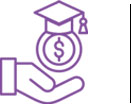
Financial Barriers
Education Costs Too Much
Education is becoming less accessible—not because girls aren’t capable, but because they can’t afford it.
63%
of young women in the U.S. say financial constraints limit their ability to pursue education.
— National Women’s History Museum
1 in 10
girls from low-income households globally finishes secondary school.
— UNESCO
$929Billion
in U.S. student loan debt is held by women—nearly two-thirds of the total—limiting their future opportunities.
— American Association of University Women (AAUW)
Billion

Resource Gaps
Tools, Mentors, and Support Are Missing
Even when education is free or affordable, girls often lack access to essential support systems, supplies, or guidance.
1 in 5
students in low-income areas in the U.S. don’t have access to academic counseling or mentorship.
— U.S. Department of Education
Only 15%
of students from low-income schools have access to college prep or financial literacy programs.
— Education Trust
70%
of girls from under-resourced communities say they feel “uncertain” or “alone” when applying to college.
— Girl Up & Malala Fund Survey
Why It Matters
10–20%
Increase in lifetime income for each year of education a girl completes.
That could mean tens of thousands more over a lifetime.
— UNESCO
$30 Billion
could be added to the global economy by closing the education gap for girls.
— World Bank
122 Million
Girls worldwide are out of school, missing out on basic or secondary education opportunities.Women
— UNESCO

Why It Matters
At HERS Foundation, we’re addressing these gaps head-on through:
- The “Her Future” Scholarship Fund – for girls with big dreams but limited means.
- Her Academy – free classes and resources to equip girls with skills for life and school.
- Her Guide – mentorship from successful women who’ve been there and want to help.
Because when a girl gets the support she deserves, there’s no limit to what she can achieve.
